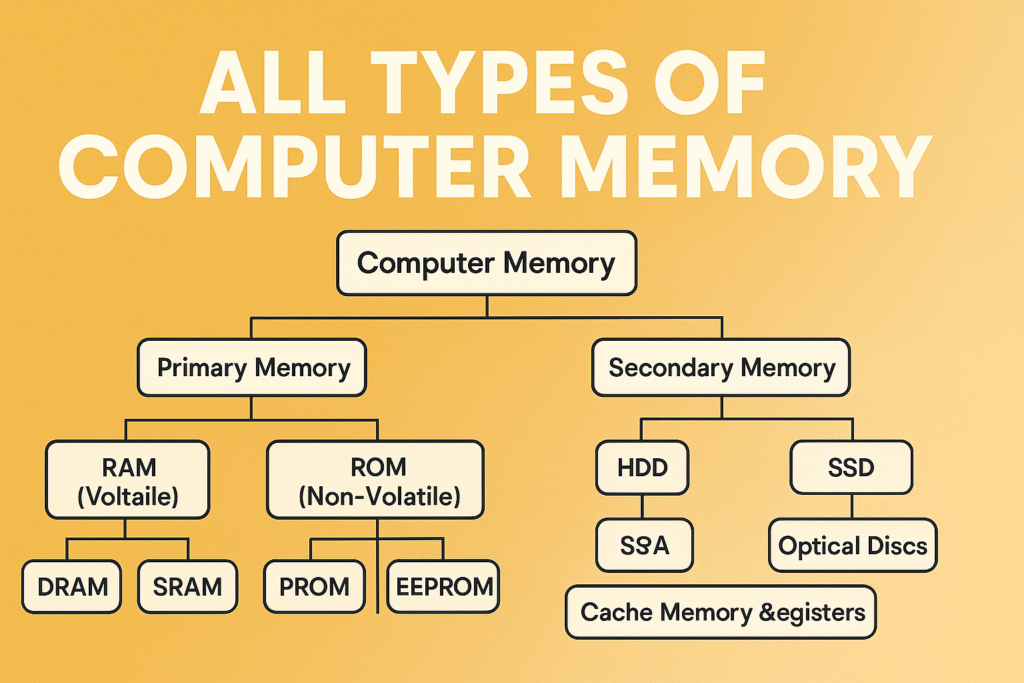Computer Memory

✅ For CBSE | ✅ Competitive Exams | ✅ Computer Science Fundamentals
🔰 What is Computer Memory?
Computer memory is the storage space where data, instructions, and information are stored temporarily or permanently. It is essential for processing, storing files, running applications, and even starting the system.
Types of Memory in Computers
Computer memory is classified into:
Computer Memory
├── Primary Memory
│ ├── RAM (Volatile)
│ │ ├── DRAM
│ │ └── SRAM
│ └── ROM (Non-Volatile)
│ ├── PROM
│ ├── EPROM
│ └── EEPROM
├── Secondary Memory
│ ├── HDD
│ ├── SSD
│ ├── Optical Discs
│ └── Flash Drives
└── Cache Memory & Registers
1️⃣ Primary Memory (Main Memory)
This memory is directly accessible by the CPU and is used to store data currently in use.
➤ A. RAM (Random Access Memory)
- Volatile → Data is lost when power is off.
- Temporary storage for running programs and OS.
🔹 Types of RAM:
| Type | Description | Speed | Cost |
|---|---|---|---|
| DRAM | Dynamic RAM – needs refreshing | Medium | Low |
| SRAM | Static RAM – no refreshing needed | High | High |
📝 Note: DRAM is used in most computers for main memory, while SRAM is used for cache memory.
➤ B. ROM (Read-Only Memory)
- Non-volatile → Retains data after shutdown.
- Contains firmware (e.g., BIOS).
🔹 Types of ROM:
| Type | Description |
|---|---|
| PROM | Programmable once by the user |
| EPROM | Can be erased with UV light and reprogrammed |
| EEPROM | Can be erased electronically |
📝 Note: EEPROM is used in modern BIOS chips.
2️⃣ Secondary Memory (Storage Devices)
Used for long-term, permanent data storage. It is non-volatile and not directly accessible by the CPU.
🔹 Hard Disk Drive (HDD)
- Magnetic storage
- Large capacity (500 GB – 10 TB)
- Slower due to mechanical parts
🔹 Solid State Drive (SSD)
- Flash memory, no moving parts
- Faster, more reliable
- More expensive than HDD
🔹 Optical Discs
- Use laser technology for reading/writing
- Types:
- CD (700 MB)
- DVD (4.7 GB)
- Blu-ray (25–128 GB)
🔹 Flash Drives (Pen drives)
- USB-based portable storage
- Uses EEPROM
- Used for quick file transfer
3️⃣ Cache Memory
Cache memory is a high-speed memory located close to the CPU. It stores frequently used data/instructions to reduce access time.
| Level | Location | Speed | Size |
|---|---|---|---|
| L1 | Inside CPU | Fastest | 32KB – 512KB |
| L2 | Near CPU | Very Fast | 256KB – 2MB |
| L3 | Shared Cache | Fast | 4MB – 16MB |
📝 Note: Cache memory increases the CPU’s performance significantly.
4️⃣ CPU Registers
- Very small, very fast memory inside the CPU.
- Holds data and instructions currently being processed.
- Types: Accumulator, Instruction Register, Program Counter, etc.
5️⃣ Virtual Memory
When the RAM is full, the operating system uses a part of the hard disk as Virtual RAM.
- Slower than real RAM
- Prevents system crashes due to memory overflow
6️⃣ Buffer vs Cache
| Feature | Buffer | Cache |
|---|---|---|
| Purpose | Manage data between devices | Store frequent data for quick access |
| Used in | Printers, video playback | CPU, disk access |
🔄 Volatile vs Non-Volatile Memory
| Feature | Volatile Memory | Non-Volatile Memory |
|---|---|---|
| Power Dependency | Loses data when off | Retains data |
| Speed | Faster | Slower |
| Examples | RAM, Cache, Registers | ROM, SSD, HDD, Flash Drive |
📊 Comparison Table
| Memory Type | Volatile | Speed | Cost | Size | Common Use |
|---|---|---|---|---|---|
| Registers | Yes | Fastest | Very High | Bytes | CPU processing |
| Cache | Yes | Very Fast | High | KB to MB | Reduce memory access delay |
| RAM | Yes | Fast | Medium | GB | Run applications |
| ROM | No | Medium | Low | MB | Booting, firmware |
| HDD | No | Slow | Low | TB | Permanent storage |
| SSD | No | Fast | High | GB to TB | OS, software storage |
| Flash Drive | No | Medium | Medium | GB | Portable storage |
📚 Real-World Application Examples
| Activity | Memory Used |
|---|---|
| Booting the computer | ROM (BIOS) |
| Running apps like Chrome | RAM |
| Storing movies | HDD/SSD |
| Storing OS permanently | SSD/HDD |
| Data transfer via USB | Flash Drive |
| Fast data for CPU | Cache memory |
✅ Quick Summary
- RAM = Temporary working memory (Volatile)
- ROM = Permanent startup instructions (Non-volatile)
- Cache/Register = Fastest memories for CPU
- HDD/SSD/USB = Permanent external/internal storage
- Virtual Memory = Part of disk used as extra RAM
📝 FAQs
Q1. What’s the difference between RAM and ROM?
➤ RAM is temporary, volatile memory. ROM is permanent and non-volatile.
Q2. Why is SSD faster than HDD?
➤ SSD has no moving parts, so data access is quicker.
Q3. What’s the fastest memory in a computer?
➤ CPU Registers are the fastest.
Q4. Why do we need cache memory?
➤ To reduce the CPU’s data access time and improve performance.
Q5. Is flash memory volatile?
➤ No, flash memory (like in SSDs and USBs) is non-volatile.

